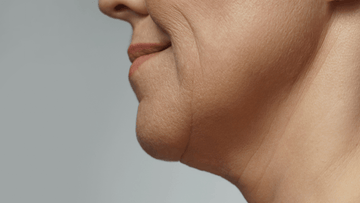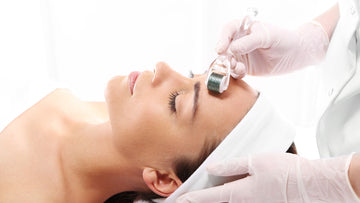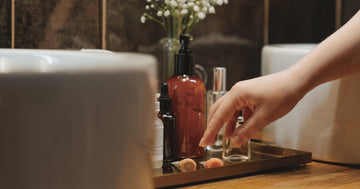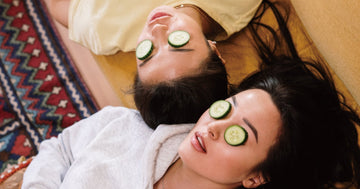The Mechanism of Skin Aging & the Best Time for Anti-Aging: What You Need to Know


Written by: Wei-Hsiang Yang, Master's student in Cosmetic Science, specializing in skincare science
You might think that skin aging is a phenomenon of "sudden aging," but in reality, it is a gradual and silent process. As we age, collagen and elastic fibers in the dermis gradually diminish, the rate of epidermal renewal slows down, and external stimuli (such as UV rays, air pollution, and lifestyle habits) lead to oxidative stress, which accelerates the degradation of these structures and functions. When these mechanisms occur simultaneously, we can see wrinkles, sagging, dryness, and uneven pigmentation in the mirror. Below, we will clarify these aging mechanisms one by one and indicate when to start "preventive care" to delay the signs of aging in the gentlest and most effective way possible.
Definition and Classification of Skin Aging
Skin aging can be broadly divided into two categories:
Intrinsic Aging
Dominated by genetics, hormonal changes, and natural timing, it is a systemic physiological aging.
Characteristics:Fine wrinkles, thinning skin, reduced uniformity of skin tone, usually becoming apparent in middle age.
Extrinsic Aging
Caused by external damage such as sun exposure (UVA/UVB), air pollution, smoking, and poor lifestyle habits.
Characteristics:Deep wrinkles, sagging, pigmentation, rough skin, and significant loss of elasticity.
These two aging effects arecumulative: intrinsic aging provides the "base color" of aging, while extrinsic aging determines the "speed" and "type" of aging.
| Classification | Main Causes | Common Manifestations |
|---|---|---|
| Intrinsic | Genetics, hormones, time | Fine lines, dull skin tone, thinning skin, reduced elasticity |
| Extrinsic | UV rays, air pollution, lifestyle, stress, smoking | Deep wrinkles, pigmentation, sagging, roughness, uneven skin tone |
Analysis of Aging Mechanisms
1. Loss of collagen and elastic fibers
Starting in your twenties, the body's synthesis of collagen begins to slow down, losing about 1%–1.5% each year. If you imagine the skin as a trampoline, collagen is like the springs: as the springs gradually relax and deform, the skin naturally loses its elasticity and firmness.

Aging's impact on collagen and structure in the dermis(Cited fromAge-related dermal collagen changes during development, maturation and ageing – a morphometric and comparative study. Journal of Anatomy. 2014)
(D): Scatter plot of collagen area (collagen bundle density) in the dermis by age
(E): Collagen density of a 40-year-old subject, with an average collagen proportion in the dermis of73.63%
(The blue area in the figure represents collagen distribution)
(F): Collagen density of a 95-year-old subject, with an average collagen proportion in the papillary dermis of43.27%
(The blue area in the figure represents collagen distribution)
Another interesting fact is that sugar can worsen skin condition. Consuming too much refined sugar leads to the production of excessive substances known as "AGEs" (Advanced Glycation End Products), which can make collagen brittle and hard, and even give the skin a yellower appearance. AGEs are significant contributors to aging and chronic inflammation, accumulating in skin tissues, damaging barriers, triggering pigmentation, harming keratinocytes, and disrupting collagen structure. AGEs cause the skin surface to become dry and dull, and the underlying collagen and extracellular matrix to relax, making them one of the most common sources of aging skin.
2. Oxidative stress, free radical damage, and photoaging
UV rays, air pollution, stress, and even long-term lack of sleep can lead to the production of a large number of free radicals in the skin. These free radicals act like uncontrollable fireballs, rampaging through the skin, attacking collagen, cell membranes, and DNA, gradually destroying skin structure. To deal with these free radicals, the body activates matrix metalloproteinases (MMPs), but these enzymes instead accelerate the breakdown of collagen and elastic fibers in the dermis, causing the skin to sag, develop wrinkles, and pigmentation, making aging occur faster. There is no anti-aging without sunscreen; it is just counterproductive.Sunscreen is your most direct and powerful first line of defense against free radicals and photoaging.

3. Slowed cell renewal and accumulation of senescent cells
Another undeniable fact is that we all gradually age. In youth, skin renewal takes about 28 days. However, as we age, this cycle may extend to 40 days or even longer. The slowing metabolism also leads to the accumulation of dead skin cells, slower pigment metabolism, and an overall dull and yellowish skin tone. Moreover, senescent cells do not just age themselves; they release inflammatory substances that weaken surrounding healthy cells, effectively "dragging down the overall performance." This results in increasingly poor skin condition.
"Prevention is better than cure" is not only a medical adage but also a golden rule in skincare. The recent trend of Prejuvenation emphasizes this principle once again: don’t wait until "aging becomes visible" to start, as it is usually too late by then. Therefore, we have compiled the following key points for anti-aging care based on different age groups.
20–24 years: Stabilizing skin condition + early anti-aging starting point
Key Ingredients:
- Sunscreen (SPF30+): To combat UV-induced photoaging.
- Stabilized antioxidants (Vitamin C derivatives, polyphenols, plant extracts): To neutralize free radicals and reduce dullness.
- Entry-level retinol (≤ 0.1%): Gently regulates metabolism.
- Basic peptides (oligopeptides, hexapeptides): Provide signals for collagen synthesis.
Why is it important? At this stage, skin metabolism is still good, but collagen is already slowly diminishing. Early use of antioxidants to stabilize the environment, combined with gentle retinol and peptides for long-term preparation, helps reduce the subsequent incidence of aging.
25–30 years: Officially activate the anti-aging golden triangle structure
Key Ingredients:
- Retinol (0.1–0.3%): Stimulates epidermal renewal and dermal collagen production, preventing fine lines and pore deterioration.
- Multiple peptides (palmitoyl tripeptide/pentapeptide, tetrapeptide-7): Support collagen synthesis and skin repair.
- High-efficiency antioxidant complex: At this stage, it is no longer sufficient to use a single antioxidant ingredient; a variety of antioxidant components are needed to comprehensively reduce oxidative damage from the environment and lower MMPs expression.
- Continuous sunscreen: To avoid long-term damage to the dermal scaffold and DNA from UV rays.
Why is it important? At this stage, collagen significantly declines, and skin begins to deteriorate. A combination of antioxidants and repair is key to extending the "golden period of skin age." Retinol helps renew the skin, peptides help build a solid foundation, and antioxidants maintain overall stability.
30 years and above: Focus on structural stability to combat visible signs of aging
Key Ingredients:
- Retinol (0.1–0.3%) or advanced retinol complex: Strengthens conditioning for changes in skin condition, fine lines, and roughness.
- Advanced peptide combinations (signal-type + inhibitory-type): Stabilize collagen structure, enhance elasticity and firmness.
- Antioxidant defense network (high concentration L-ascorbic acid + polyphenols or green tea extract): Neutralize ROS, reduce pigmentation and uneven skin tone.
- Sunscreen remains essential daily: Aging accumulates, and UV rays will not "be polite."
Why is it important? After 30, aging is no longer "predicted," but visibly changing. You need a stable structural care system: Retinol maintains metabolic momentum, peptides reinforce the supporting structure, antioxidants serve as a barrier defense, and sunscreen combats the root cause.
Age Group × Strategy Overview
| Age Range | Primary Anti-Aging Battlefield | Recommended Strategy Logic | Usage Strategy | Recommended Product Role |
|---|---|---|---|---|
| 20–24 | Stabilization + Defense | Delay initial collagen loss, block free radical chain destruction | Daytime: Sunscreen + Antioxidants Nighttime: Build retinol tolerance |
Antioxidant brightening essence + sunscreen |
| 25–30 | Activate collagen regeneration cycle | Simultaneous antioxidant + repair to prevent the development of wrinkles and sagging | Daytime: Sunscreen + Antioxidants Nighttime: Gentle retinol + peptides |
Peptide essence, antioxidant essence + sunscreen |
| 30+ | Combat structural aging | Actively repair structural looseness, reduce collagen depletion and pigmentation accumulation | Daytime: Sunscreen + Antioxidants Nighttime: Advanced retinol + peptide combination for all-day defense |
High-concentration peptides and retinol essence + antioxidants + sunscreen |
References
- Jean Ayer. Skin aging. DermNet NZ. 2018.
- Rodan + Fields. Understanding the Difference Between Intrinsic and Extrinsic Aging. 2021.
- Oyetakin-White P, et al. Skin collagen through the lifestages: importance for skin health and beauty. J Cosmet Dermatol. 2020.
- Benben Sun, et al. Protecting and rejuvenating ageing skin by regulating HA metabolism. Front Med. 2025.
- Katta R, Baxt R. Dermatologist-recommended skin care for your 20s. American Academy of Dermatology (AAD). 2021.
- Verywell Health. Skin Elasticity and Aging. 2022.
- Chang E. If you start injectables young, can you prevent aging? American Society of Plastic Surgeons (ASPS) Blog. 2021.
- Hughes MC, et al. Sunscreen and prevention of skin aging: a randomized trial. Ann Intern Med. 2013.
- Diala Haykal, Foad Nahai, Hugues Cartier. Prejuvenation: The Global New Anti-Aging Trend. Aesthetic Surg J Open Forum. 2023.
- Age-related dermal collagen changes during development, maturation and ageing – a morphometric and comparative study. J Anat. 2014.
- Skin senescence – from basic research to clinical practice. Front Med (Lausanne). 2024.
- Trucker accumulates skin damage on left side of his face after 28 years on the road. CBS News. 2012.


